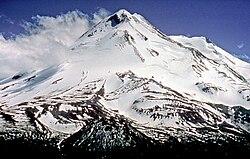Native Americans
For several thousand years prior to the 19th century, Big Bend was the heart of the territory of the Madesi tribe (pronounced Mah-day-see) tribe (or "band") of Pit River Native Americans. The Madesi is one of nine bands (also called "tribelets") that spoke the Achomawi language. (Early anthropologists mistakenly called all nine bands in the language group "Achomawi," although only one of the bands was actually called Achomawi.) [2]
The Madesi band's territorial region included Big Bend and the surrounding area of the Lower Pit River (Ah-choo'-mah in the Madesi dialect, which has few or no speakers still living), and several of its tributaries, such as Kosk Creek (An-noo-che'che) and Nelson Creek (Ah-lis'choo'-chah). The main village of the Madesi was on the north bank of the Pit River, east of Kosk Creek, and was called Mah-dess', or Mah-dess' Atjwam (Madesi Valley), and was directly across the river from the smaller villages that surrounded the hot springs on the river's south bank, which were called Oo-le'-moo-me, Lah'-lah-pis'-mah, and Al-loo-satch-ha. [3]
The Madesi people enjoyed great abundance of food sources, which mainly consisted of acorns, deer, salmon, and other fish from the river.
Euro-American settlers
The Big Bend area is so remote and isolated that the Madesi was one of the last indigenous peoples of California to be invaded and pushed out of their ancestral homeland.
As white settlers began to come to Big Bend in the 1860s, few Madesi were left in the area, and the newcomers began to claim the conquered land as their own. By the 1890s, Big Bend was becoming a small quiet town of white settlers, centered around the hot springs. It was originally called Elena (1890) by the Euro-Americans settlers, and then changed to Henderson, (1906) before they began calling it "Big Bend" (1922).
Early white settlers built a log hotel with a post office and a saloon just above the main hot springs. Many visitors around the turn of the 20th-century came to Big Bend to soak in the hot springs, seeking the reputed healing qualities of the hot mineral water baths.
Big Bend grew slowly until the late 1930s, when Pacific Gas and Electric Company began construction on the Pit Five Hydroelectric Dam and Pit Five Power House. [4] The dam construction brought thousands of jobs and people to Big Bend. This included engineers, builders, tunnel diggers (around 2000 hard-rock miners), and service workers to the area. Big Bend saw a "boom and bust" cycle, and the population was declining by the late 1940s, after the dam work was completed. Although the maintenance of the hydroelectric facilities and a large commercial logging industry still require numerous employees, almost all of the people working in such jobs live outside of Big Bend, contributing further to the population decline.
The population of Big Bend was only 102 people in the 2010 census, apparently the lowest number of residents since the 1860s. [5]


